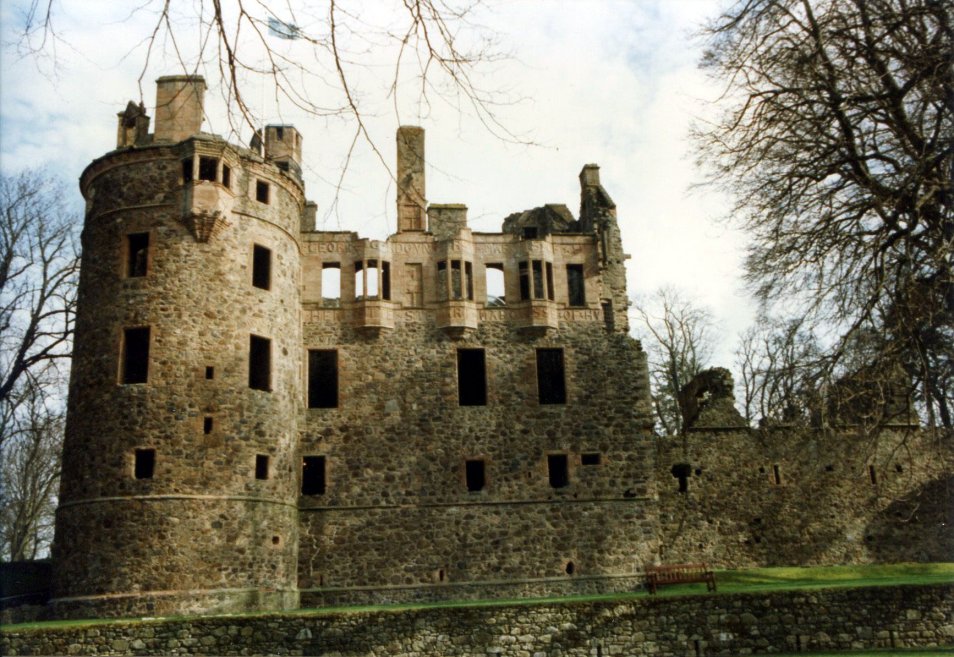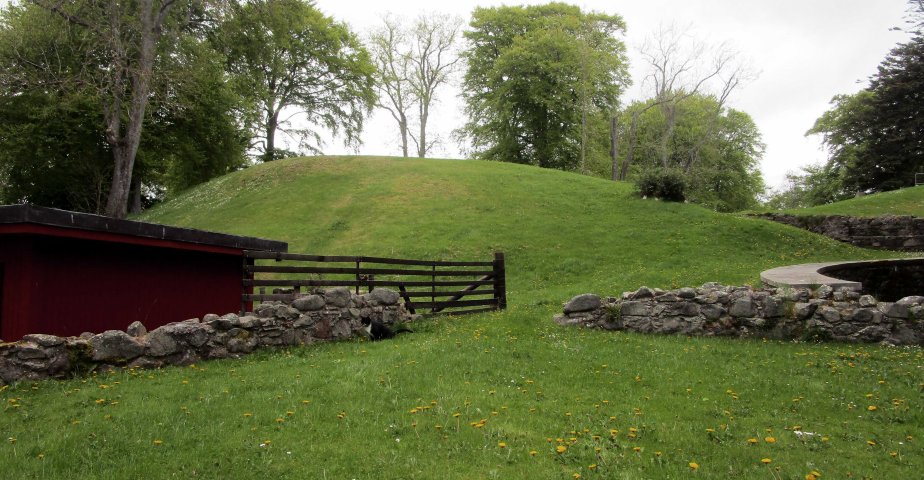Huntly

Three different castles have stood near the
crossing of the River Deveron at
its confluence with the Bogie. The first, the Peel of
Strathbogie, was
an earthwork motte and bailey built in the late twelfth
century. The second, built in the late fourteenth century on
the bailey of the first castle, was an L plan tower of the
Gordons. The third,
making use of the later, is the fifteenth century palace that stands
next to the tower and
motte today.
Strathbogie was an important route crossing from the
heartlands of the kingdom of Scotland into Moray and controlled the
route northwards via Kildrummy
to Rothes, Elgin
and Inverness. Consequently it may have been fortified by one of
the Scottish kings pushing into Moray
in the period 1130-1230. Certainly by the late twelfth century
King
William the Lion (d.1214) had settled Earl Duncan of Fife
(bef.1155-1204) in the district. Presumably he built the peel of
Strathbogie now called Huntly castle. Strathbogie then passed
through Duncan's third son, David, to the his descendants, the earls of
Athol. On 7 November 1306, Earl John Strathbogie of Athol was
hanged in London by King Edward I (d.1307) for his rebellion in
supporting
Robert Bruce and assisting in his coronation. In late 1307
Robert
Bruce was taken to the castle after being wounded or falling ill at
Inverurie. He went on to defeat and all but annihilate the
Comyn
earls of Buchan and their supporters.
Earl John's son, Earl David Strathbogie of
Athol (d.1326), was restored to his lands and became high constable of Scotland
for Bruce, until just before Bannockburn when he turned back to the
English cause. Consequently King Robert granted his lands to
Adam
Gordon of Huntly in Berwickshire and David returned to England where he
appeared in parliament as Lord Strathbogie in 1322. He died
in
1326, probably in Gascony where he was commanding English
troops.
His son, David (d.1335), was summoned to the English parliament as earl of Athol
in 1330. In 1332 King Edward Balliol of Scotland restored him to his
estates, including Huntly. He then rebelled against Balliol,
made
his peace, and finally fell fighting on 30 November 1335 at the battle
of Killblane while trying to establish his rule over
Kildrummy.
This effectively ended the Strathbogies ownership of Huntly, although
he left a son, another David, who died in 1369 leaving two daughters
who married English barons. It was in this period from
1314-69
that the castle became known as Huntly after its new Gordon masters, rather than Strathbogie.
The Gordons died out in 1408
and the
castle passed to Alexander Seton (d.1441), who had married Elizabeth Gordon (d.1437), the
sister of John (d.1408), the last Gordon lord of Huntly. In 1436
Alexander
Seton was created Lord Huntly and some ten years later (1445/9) his
son, another Alexander, was made earl of Huntly. In 1452 the
earl
moved south with an army to support the king against the Black
Douglases. While he was still moving south Earl Archibald
Douglas
of Moray attacked Huntly and burned the castle, forcing Seton to about
face and march to the relief of his earldom where broke the power of
the Douglases of Moray. It was probably after this that the
new
palace was built on the south side of the bailey. Only the
basement of his now remains. It was unfinished when the earl
died
in 1470 and was buried under a fine effigy in Elgin
cathedral.
The palace was then finished by the earl's son and heir, Earl George of
Huntly.
King James IV attended the marriage of
the pretender
to the English throne, Duke Richard of York, aka Perkin Warbeck
(d.1499), to Lady Catherine Gordon (d.1537) in
January 1496. Building work may still have been going on at
this
time as the king paid ‘drinksilver' to masons there in 1501
and
1505. In 1506 Earl Alexander received a charter confirming
him in
his ‘chief messuage, which was formerly called Strathbogie,
be in
all future times named the castle of Huntly'. In 1556 the
Queen
Regent, Mary of Guise, visited this, the chief stronghold of the
Catholic Gordon earls of Huntly. It was then described as a
‘new expensive stately building, which he (Earl George) had
joined to the old castle and rendered a very convenient
palace'.
By 1562 the castle was the headquarters of the counter-reformation in
Scotland. The same year, after the earl of Huntly's defeat
and
death by apoplexy at the battle Corrichie by the army of Mary Queen of
Scots, the castle was pillaged of
its contents. This included the treasures of St Machar's
Cathedral, Aberdeen, one of which was the silk tent that King Edward II
had slept in before the battle of Bannockburn in 1314.
At the time the castle was described by the English diplomat Thomas
Randolph as 'fayer, beste furnishede of anye howse that I have seen in
thys countrie'.
Rebuilding
work was going on at the castle in July 1594 when the English
ambassador reported that ‘Huntly hastens the building of his
hall
and gallery at Strathbogy'. Huntly then began a rash
rebellion
with the result that King James VI marched on Huntly castle and then
blew up ‘the greate olde tower' on the north side of the bailey
with
gunpowder supplied to him by the townsfolk of Aberdeen. The
earl
made peace with the king in 1597 and set about repairing the castle
after being made first marquis of Huntly. One of the
fireplaces
has the date March 1606 carved upon it. Another has a
portrait of
the earl in a top hat next to his wife.
In the troubled seventeenth century, the castle was
fortified
with a ravelin, probably before being occupied by the Covenanters in
1640. The castle was then sacked and slightly
damaged. In
1647 the garrison under Lord Charles Gordon was starved out by General
David Leslie and its 'Irish' garrison were hanged and their officers
beheaded. In December of the same year Huntly himself was
captured and on his way to execution at Edinburgh was detained in his
own mansion. His escort were shot against its walls and the
marquis was executed after stating ‘You may take my head from
my
shoulders, but not my heart from my sovereign'. In
1650
Charles II visited briefly on his way to the battle of Worcester,
defeat and exile. The palace was briefly the centre of
rebellion
in 1689, but saw no action. Within a decade the castle was
being
pillaged of stone by local villagers. Despite this the castle
was
finally occupied by government troops in 1745 before being allowed to
fall into terminal decay.
 Description
Description
The motte, some 80' in basal diameter, and traces of the bailey under
the current castle are all that remains of the original Strathbogie castle. At some point the bailey had the L
shaped
tower added to it with walls nearly 9' thick. This structure has now
been
reduced to its foundations. Traditionally such towers were only built
in
the late fourteenth or early fifteenth century. Examples of such exist at Auchindoun, Dalhousie and Dunnottar. There may also have
been a curtain wall around the bailey at this time.
The third phase of the castle, the
palace, is best
preserved. This appears to be of three periods; the earliest
is
represented by three basement vaults and a dark prison pit cut into the
foundations. Early graffiti survives on the plaster of the
corridor. In the middle of the sixteenth century the fourth earl is
thought
to have rebuilt this castle from the ground floor up. On the
first floor is the earl's apartment, the traditional arrangement of
hall, great chamber and inner chamber with bed recess and
privy.
The arrangement of the floor above, for the earl's wife, would have
been similar. In the upper hall is one of the splendid
heraldic
mantelpieces inserted by George, first marquis, in the third building
phase. This shows the arms of Huntly and Lennox with the
royal
arms above. In between are obelisks bearing the Seton
crescents
and Lennox fleur de lis. The topmost panel was removed by the
Covenanter, Capt James Wallace, as it was of a sacred subject.
Adjoining this block is a round tower to
the south-west. At the top of this, some 65' above ground level, is a
'belvedere' or turret room. The first marquis (d.1636) also
added
the impressive heraldic frontispiece over the main doorway and the
gracious oriel windows on the S front. The frieze of one
contains
giant relief letters stating, GEORGE GORDOVN FIRST MARQVIS OF HUNTLIE
and HENRIETTE STEVART MARQVESSE OF HVNTLIE. This has been
dated
to 1602.
Further wings were added to the castle
in the sixteenth and seventeenth centuries.
Why not join me at Huntly
and other Great
Scottish Castles this Spring?
Information on tours at Scholarly
Sojourns.
Copyright©2019
Paul Martin Remfry


 Description
Description